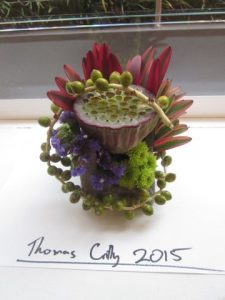 We had a five hours hands-on workshop with nineteen male students. Lunch and afternoon tea were catered for all of us. The workshop was set up outside the art studio with a few long tables. The autumn weather was perfect for working outside undercover. The students were inspired with my power point presentation. I gave a quick briefing on the truck load of ephemeral materials I provided, showing some creative ideas and techniques on how to use materials such as big Gymea leaves, Ficus leaves, branches, sticks, flowers, apples, chilies, etc. They were not the usual palettes for art class. They used scissors and knifes for cutting, wiring, tearing, gluing, sewing, weaving – no paint, no brushes. Each student had to construct two artworks, a wall hanging piece and a sculpture. They took their time to select materials, it didn’t take them long to get connected with nature. I was very pleased to see their enthusiasm working with the materials. Every student managed to complete two creative works. They continued to document the aesthetic changes in time. For example, fresh leaves changed in colours and shapes when drying. I was satisfied with the workshop. The teachers were very pleased with the results. The students demonstrated their designs very well, showing lines, space, forms, colours, shadows, etc. This was based on the Ikebana design principle, ‘Less is More’- a task sheet concept provided by their Teacher.
We had a five hours hands-on workshop with nineteen male students. Lunch and afternoon tea were catered for all of us. The workshop was set up outside the art studio with a few long tables. The autumn weather was perfect for working outside undercover. The students were inspired with my power point presentation. I gave a quick briefing on the truck load of ephemeral materials I provided, showing some creative ideas and techniques on how to use materials such as big Gymea leaves, Ficus leaves, branches, sticks, flowers, apples, chilies, etc. They were not the usual palettes for art class. They used scissors and knifes for cutting, wiring, tearing, gluing, sewing, weaving – no paint, no brushes. Each student had to construct two artworks, a wall hanging piece and a sculpture. They took their time to select materials, it didn’t take them long to get connected with nature. I was very pleased to see their enthusiasm working with the materials. Every student managed to complete two creative works. They continued to document the aesthetic changes in time. For example, fresh leaves changed in colours and shapes when drying. I was satisfied with the workshop. The teachers were very pleased with the results. The students demonstrated their designs very well, showing lines, space, forms, colours, shadows, etc. This was based on the Ikebana design principle, ‘Less is More’- a task sheet concept provided by their Teacher.
1 – Day workshop: Ikebana – Japanese Inspired Sculpture
Spring Hill
15 May 2015
Lily Karmatz – Flying Arts Artist
Flying Arts’ Touring Artist Journal is brought to you monthly thanks to Art Shed Brisbane.
